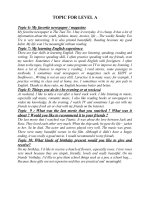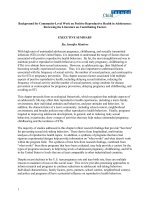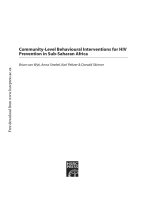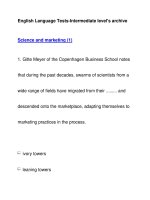GCSE (9-1) MATHEMATICS SPECIFICATION PEARSON EDEXCEL LEVEL 1LEVEL 2 GCSE (9 - 1) IN MATHEMATICS (1MA1)
Bạn đang xem bản rút gọn của tài liệu. Xem và tải ngay bản đầy đủ của tài liệu tại đây (1.02 MB, 54 trang )
GCSE (9-1)
Mathematics
Specification
Pearson Edexcel Level 1/Level 2 GCSE (9 - 1) in Mathematics (1MA1)
First teaching from September 2015
First certification from June 2017 Issue 2
Pearson
Edexcel Level 1/Level 2
GCSE (9–1)
in Mathematics (1MA1)
Specification
First certification 2017
Issue 2
Edexcel, BTEC and LCCI qualifications
Edexcel, BTEC and LCCI qualifications are awarded by Pearson, the UK’s largest awarding
body offering academic and vocational qualifications that are globally recognised and
benchmarked. For further information, please visit our qualification websites at
www.edexcel.com, www.btec.co.uk or www.lcci.org.uk. Alternatively, you can get in
touch with us using the details on our contact us page at
qualifications.pearson.com/contactus
About Pearson
Pearson is the world's leading learning company, with 40,000 employees in more than
70 countries working to help people of all ages to make measurable progress in their lives
through learning. We put the learner at the centre of everything we do, because
wherever learning flourishes, so do people. Find out more about how we can help you
and your learners at qualifications.pearson.com
This specification is Issue 2. Key changes are sidelined. We will inform centres of any
changes to this issue. The latest issue can be found on our website.
References to third party material made in this specification are made in good faith.
Pearson does not endorse, approve or accept responsibility for the content of materials,
which may be subject to change, or any opinions expressed therein. (Material may
include textbooks, journals, magazines and other publications and websites.)
All information in this specification is correct at time of publication.
ISBN 978 1 446 92720 5
All the material in this publication is copyright
© Pearson Education Limited 2015
From Pearson’s Expert Panel for World Class Qualifications
“The reform of the qualifications system in England is a profoundly important change
to the education system. Teachers need to know that the new qualifications will assist
them in helping their learners make progress in their lives.
When these changes were first proposed we were approached by Pearson to join an
‘Expert Panel’ that would advise them on the development of the new qualifications.
We were chosen, either because of our expertise in the UK education system, or
because of our experience in reforming qualifications in other systems around the
world as diverse as Singapore, Hong Kong, Australia and a number of countries across
Europe.
We have guided Pearson through what we judge to be a rigorous qualification
development process that has included:
● Extensive international comparability of subject content against the highest-
performing jurisdictions in the world
● Benchmarking assessments against UK and overseas providers to ensure that they
are at the right level of demand
● Establishing External Subject Advisory Groups, drawing on independent subject-
specific expertise to challenge and validate our qualifications
● Subjecting the final qualifications to scrutiny against the DfE content and Ofqual
accreditation criteria in advance of submission.
Importantly, we have worked to ensure that the content and learning is future
oriented. The design has been guided by what is called an ‘Efficacy Framework’,
meaning learner outcomes have been at the heart of this development throughout.
We understand that ultimately it is excellent teaching that is the key factor to a
learner’s success in education. As a result of our work as a panel we are confident that
we have supported the development of qualifications that are outstanding for their
coherence, thoroughness and attention to detail and can be regarded as representing
world-class best practice.”
Sir Michael Barber (Chair) Professor Sing Kong Lee
Chief Education Advisor, Pearson plc
Director, National Institute of
Education, Singapore
Bahram Bekhradnia Professor Jonathan Osborne
President, Higher Education Policy Institute Stanford University
Dame Sally Coates Professor Dr Ursula Renold
Principal, Burlington Danes Academy
Federal Institute of Technology,
Switzerland
Professor Robin Coningham Professor Bob Schwartz
Pro-Vice Chancellor, University of Durham
Harvard Graduate School of
Education
Dr Peter Hill
Former Chief Executive ACARA
Introduction
The Pearson Edexcel Level 1/Level 2 GCSE (9 to 1) in Mathematics is designed for
use in schools and colleges. It is part of a suite of GCSE qualifications offered by
Pearson.
Purpose of the specification
This specification sets out:
● the objectives of the qualification
● any other qualification that a student must have completed before taking the
qualification
● any prior knowledge and skills that the student is required to have before taking
the qualification
● any other requirements that a student must have satisfied before they will be
assessed or before the qualification will be awarded
● the knowledge and understanding that will be assessed as part of the
qualification
● the method of assessment and any associated requirements relating to it
● the criteria against which a student’s level of attainment will be measured (such
as assessment criteria).
Rationale
The Pearson Edexcel Level 1/Level 2 GCSE (9–1) in Mathematics meets the
following purposes, which fulfil those defined by the Office of Qualifications and
Examinations Regulation (Ofqual) for GCSE qualifications in their GCSE (9 to 1)
Qualification Level Conditions and Requirements document, published in April 2014.
The purposes of this qualification are to:
● provide evidence of students’ achievements against demanding and fulfilling
content, to give students the confidence that the mathematical skills, knowledge
and understanding that they will have acquired during the course of their study
are as good as that of the highest performing jurisdictions in the world
● provide a strong foundation for further academic and vocational study and for
employment, to give students the appropriate mathematical skills, knowledge
and understanding to help them progress to a full range of courses in further
and higher education. This includes Level 3 mathematics courses as well as
Level 3 and undergraduate courses in other disciplines such as biology,
geography and psychology, where the understanding and application of
mathematics is crucial
● provide (if required) a basis for schools and colleges to be held accountable for
the performance of all of their students.
Qualification aims and objectives
The aims and objectives of the Pearson Edexcel Level 1/Level 2 GCSE (9–1) in
Mathematics are to enable students to:
● develop fluent knowledge, skills and understanding of mathematical methods
and concepts
● acquire, select and apply mathematical techniques to solve problems
● reason mathematically, make deductions and inferences, and draw conclusions
● comprehend, interpret and communicate mathematical information in a variety
of forms appropriate to the information and context.
The context for the development of this qualification
All our qualifications are designed to meet our World Class Qualification Principles[1]
and our ambition to put the student at the heart of everything we do.
We have developed and designed this qualification by:
● reviewing other curricula and qualifications to ensure that it is comparable with
those taken in high-performing jurisdictions overseas
● consulting with key stakeholders on content and assessment, including learned
bodies, subject associations, higher-education academics, teachers and
employers to ensure this qualification is suitable for a UK context
● reviewing the legacy qualification and building on its positive attributes.
This qualification has also been developed to meet criteria stipulated by Ofqual in
their documents GCSE (9 to 1) Qualification Level Conditions and Requirements and
GCSE Subject Level Conditions and Requirements for Mathematics, published in
April 2014.
[1] Pearson’s World Class Qualification principles ensure that our qualifications are:
● demanding, through internationally benchmarked standards, encouraging deep
learning and measuring higher-order skills
● rigorous, through setting and maintaining standards over time, developing
reliable and valid assessment tasks and processes, and generating confidence in
end users of the knowledge, skills and competencies of certified students
● inclusive, through conceptualising learning as continuous, recognising that
students develop at different rates and have different learning needs, and
focusing on progression
● empowering, through promoting the development of transferable skills, see
Appendix 1.
Contents
Qualification at a glance 1
Knowledge, skills and understanding 3
Foundation tier knowledge, skills and understanding 5
Higher tier knowledge, skills and understanding 12
Assessment 21
Assessment summary 21
Assessment Objectives and weightings 24
Breakdown of Assessment Objectives into strands and elements 26
Entry and assessment information 28
Student entry 28
Forbidden combinations and discount code 28
November resits 28
Access arrangements, reasonable adjustments and special
consideration 29
Equality Act 2010 and Pearson equality policy 30
Awarding and reporting 31
Language of assessment 31
Grade descriptions 31
Other information 33
Student recruitment 33
Prior learning 33
Progression 33
Progression from GCSE 34
Appendix 1: Transferable skills 37
Appendix 2: Codes 39
Appendix 3: Mathematical formulae 41
Qualification at a glance
Pearson Edexcel Level 1/Level 2 GCSE (9–1) in Mathematics
● The assessments will cover the following content headings:
1 Number
2 Algebra
3 Ratio, proportion and rates of change
4 Geometry and measures
5 Probability
6 Statistics
● Two tiers are available: Foundation and Higher (content is defined for each tier).
● Each student is permitted to take assessments in either the Foundation tier or
Higher tier.
● The qualification consists of three equally-weighted written examination papers
at either Foundation tier or Higher tier.
● All three papers must be at the same tier of entry and must be completed in the
same assessment series.
● Paper 1 is a non-calculator assessment and a calculator is allowed for Paper 2
and Paper 3.
● Each paper is 1 hour and 30 minutes long.
● Each paper has 80 marks.
● The content outlined for each tier will be assessed across all three papers.
● Each paper will cover all Assessment Objectives, in the percentages outlined for
each tier. (See the section Breakdown of Assessment Objectives for more
information.)
● Each paper has a range of question types; some questions will be set in both
mathematical and non-mathematical contexts.
● See Appendix 3 for a list of formulae that can be provided in the examination
(as part of the relevant question).
● Two assessment series available per year: May/June and November*.
● First assessment series: May/June 2017.
● The qualification will be graded and certificated on a nine-grade scale from
9 to 1 using the total mark across all three papers where 9 is the highest grade.
Individual papers are not graded.
● Foundation tier: grades 1 to 5.
● Higher tier: grades 4 to 9 (grade 3 allowed).
*See the November resits section for restrictions on November entry.
Pearson Edexcel Level 1/Level 2 GCSE (9 - 1) in Mathematics 1
Specification – Issue 2 – June 2015 © Pearson Education Limited 2015
2 Pearson Edexcel Level 1/Level 2 GCSE (9–1) in Mathematics
Specification – Issue 2 – June 2015 © Pearson Education Limited 2015
Knowledge, skills and understanding
Overview The table below illustrates the topic areas covered in this
Content qualification and the topic area weightings for the
assessment of the Foundation tier and the assessment of
the Higher tier.
Tier Topic area Weighting
Foundation Number 22 - 28%
Algebra 17 - 23%
Higher Ratio, Proportion and Rates 22 - 28%
of change
Geometry and Measures 12 - 18%
Statistics & Probability 12 - 18%
Number 12 - 18%
Algebra 27 - 33%
Ratio, Proportion and Rates 17 - 23%
of change
Geometry and Measures 17 - 23%
Statistics & Probability 12 - 18%
● All students will develop confidence and competence
with the content identified by standard type.
● All students will be assessed on the content identified by
the standard and the underlined type; more highly
attaining students will develop confidence and
competence with all of this content.
● Only the more highly attaining students will be assessed
on the content identified by bold type. The highest
attaining students will develop confidence and
competence with the bold content.
● The distinction between standard, underlined and bold
type applies to the content statements only, not to the
Assessment Objectives or to the mathematical formulae.
Pearson Edexcel Level 1/Level 2 GCSE (9 - 1) in Mathematics 3
Specification – Issue 2 – June 2015 © Pearson Education Limited 2015
Foundation tier
Foundation tier students will be assessed on content
identified by the standard and underlined type. Foundation
tier students will not be assessed on content identified by
bold type. Foundation tier content is on pages 3–9.
Higher tier
Higher tier students will be assessed on all the content
which is identified by the standard, underlined and bold
type. Higher tier content is on pages 10–18.
4 Pearson Edexcel Level 1/Level 2 GCSE (9–1) in Mathematics
Specification – Issue 2 – June 2015 © Pearson Education Limited 2015
Foundation tier knowledge, skills and
understanding
1. Number
Structure and calculation
What students need to learn:
N1 order positive and negative integers, decimals and fractions;
use the symbols =, ≠, <, >, ≤, ≥
N2 apply the four operations, including formal written methods, to integers,
decimals and simple fractions (proper and improper), and mixed numbers
– all both positive and negative; understand and use place value
(e.g. when working with very large or very small numbers, and when
calculating with decimals)
N3 recognise and use relationships between operations, including inverse
operations (e.g. cancellation to simplify calculations and expressions);
use conventional notation for priority of operations, including brackets,
powers, roots and reciprocals
N4 use the concepts and vocabulary of prime numbers, factors (divisors),
multiples, common factors, common multiples, highest common factor,
lowest common multiple, prime factorisation, including using product
notation and the unique factorisation theorem
N5 apply systematic listing strategies
N6 use positive integer powers and associated real roots (square, cube and
higher), recognise powers of 2, 3, 4, 5
N7 calculate with roots, and with integer indices
N8 calculate exactly with fractions and multiples of π
N9 calculate with and interpret standard form A × 10n, where 1 ≤ A < 10
and n is an integer
Fractions, decimals and percentages
What students need to learn:
N10 work interchangeably with terminating decimals and their corresponding
fractions (such as 3.5 and 7 or 0.375 or 3 )
2 8
N11 identify and work with fractions in ratio problems
N12 interpret fractions and percentages as operators
Pearson Edexcel Level 1/Level 2 GCSE (9 - 1) in Mathematics 5
Specification – Issue 2 – June 2015 © Pearson Education Limited 2015
Measures and accuracy
What students need to learn:
N13 use standard units of mass, length, time, money and other measures
(including standard compound measures) using decimal quantities where
appropriate
N14 estimate answers; check calculations using approximation and estimation,
including answers obtained using technology
N15 round numbers and measures to an appropriate degree of accuracy
(e.g. to a specified number of decimal places or significant figures); use
inequality notation to specify simple error intervals due to truncation or
rounding
N16 apply and interpret limits of accuracy
2. Algebra
Notation, vocabulary and manipulation
What students need to learn:
A1 use and interpret algebraic manipulation, including:
• ab in place of a ì b
ã 3y in place of y + y + y and 3 ì y
ã a2 in place of a × a, a3 in place of a × a × a, a2b in place of a × a ì b
ã a in place of a ÷ b
b
• coefficients written as fractions rather than as decimals
• brackets
A2 substitute numerical values into formulae and expressions, including
scientific formulae
A3 understand and use the concepts and vocabulary of expressions, equations,
formulae, identities, inequalities, terms and factors
A4 simplify and manipulate algebraic expressions (including those involving
surds) by:
● collecting like terms
● multiplying a single term over a bracket
● taking out common factors
● expanding products of two binomials
● factorising quadratic expressions of the form x2 + bx + c, including the
difference of two squares;
● simplifying expressions involving sums, products and powers, including
the laws of indices
6 Pearson Edexcel Level 1/Level 2 GCSE (9–1) in Mathematics
Specification – Issue 2 – June 2015 © Pearson Education Limited 2015
A5 understand and use standard mathematical formulae; rearrange formulae to
change the subject
A6 know the difference between an equation and an identity; argue
mathematically to show algebraic expressions are equivalent, and use
algebra to support and construct arguments
A7 where appropriate, interpret simple expressions as functions with inputs
and outputs.
Graphs
What students need to learn:
A8 work with coordinates in all four quadrants
A9 plot graphs of equations that correspond to straight-line graphs in the
A10 coordinate plane; use the form y = mx + c to identify parallel lines; find the
A11
A12 equation of the line through two given points or through one point with a
given gradient
identify and interpret gradients and intercepts of linear functions graphically
and algebraically
identify and interpret roots, intercepts, turning points of quadratic functions
graphically; deduce roots algebraically
recognise, sketch and interpret graphs of linear functions, quadratic
functions, simple cubic functions, the reciprocal function y = 1 with x ≠ 0
x
A14 plot and interpret graphs (including reciprocal graphs) and graphs of
non-standard functions in real contexts to find approximate solutions to
problems such as simple kinematic problems involving distance, speed and
acceleration
Solving equations and inequalities
What students need to learn:
A17 solve linear equations in one unknown algebraically (including those with
the unknown on both sides of the equation); find approximate solutions
using a graph
A18 solve quadratic equations algebraically by factorising; find approximate
solutions using a graph
A19 solve two simultaneous equations in two variables (linear/linear
algebraically; find approximate solutions using a graph
A21 translate simple situations or procedures into algebraic expressions or
formulae; derive an equation (or two simultaneous equations), solve the
equation(s) and interpret the solution
A22 solve linear inequalities in one variable; represent the solution set on a
number line
Pearson Edexcel Level 1/Level 2 GCSE (9 - 1) in Mathematics 7
Specification – Issue 2 – June 2015 © Pearson Education Limited 2015
Sequences
What students need to learn:
A23 generate terms of a sequence from either a term-to-term or a position-to-
term rule
A24 recognise and use sequences of triangular, square and cube numbers,
simple arithmetic progressions, Fibonacci type sequences, quadratic
sequences, and simple geometric progressions (rn where n is an integer,
and r is a rational number > 0)
A25 deduce expressions to calculate the nth term of linear sequences
3. Ratio, proportion and rates of change
What students need to learn:
R1 change freely between related standard units (e.g. time, length, area,
volume/capacity, mass) and compound units (e.g. speed, rates of pay,
prices, density, pressure) in numerical and algebraic contexts
R2 use scale factors, scale diagrams and maps
R3 express one quantity as a fraction of another, where the fraction is less than
1 or greater than 1
R4 use ratio notation, including reduction to simplest form
R5 divide a given quantity into two parts in a given part:part or part:whole
ratio; express the division of a quantity into two parts as a ratio; apply ratio
to real contexts and problems (such as those involving conversion,
comparison, scaling, mixing, concentrations)
R6 express a multiplicative relationship between two quantities as a ratio or a
fraction
R7 understand and use proportion as equality of ratios
R8 relate ratios to fractions and to linear functions
R9 define percentage as ‘number of parts per hundred’; interpret percentages
and percentage changes as a fraction or a decimal, and interpret these
R10 multiplicatively; express one quantity as a percentage of another; compare
R11 two quantities using percentages; work with percentages greater than
R12 100%; solve problems involving percentage change, including percentage
increase/decrease and original value problems, and simple interest
including in financial mathematics
solve problems involving direct and inverse proportion, including graphical
and algebraic representations
use compound units such as speed, rates of pay, unit pricing, density and
pressure
compare lengths, areas and volumes using ratio notation; make links to
similarity (including trigonometric ratios) and scale factors
8 Pearson Edexcel Level 1/Level 2 GCSE (9–1) in Mathematics
Specification – Issue 2 – June 2015 © Pearson Education Limited 2015









